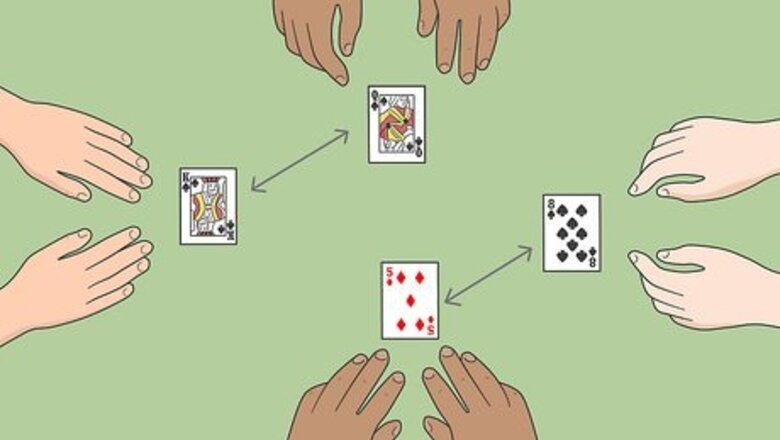
views
Setup
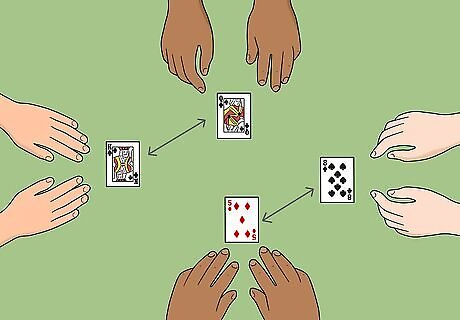
Split into teams of 2 players for a standard game. Canasta is usually a 4-player game, so find a few friends to play with. Shuffle a deck of cards and take turns picking one at random. The players with the 2 highest-ranked cards form one team and the other players form the second team. Sit across from your partner. Aces are considered the highest rank. If 2 cards have the same rank, compare the suits. When you’re setting up the game, spades are the highest, followed by hearts, diamonds, and clubs. If you’re playing with 2 or 3 people, each person plays the game individually. While you can play Canasta with 5 or 6 players, one player has to sit out of each round.
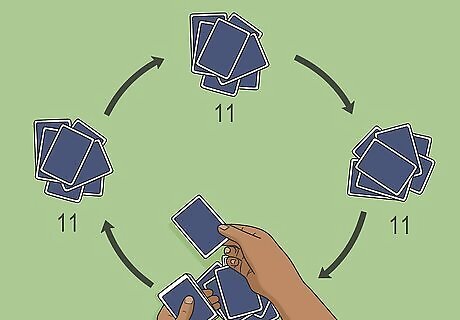
Shuffle and deal 11 cards to each player. Shuffle 2 standard decks of cards together including the jokers. Choose a player to be the first dealer and deal them face-down to each player one at a time. Set the rest of the cards in a facedown deck, or “stock,” in the middle of the table. You can look at the cards in your hand, but keep them secret from the other players, including your partner! For a 2-player game, give 15 cards to each player. For 3-player games, deal out 13 cards to each person. You may also use a commercial Canasta set that has the cards’ point values printed on them and comes with score sheets.
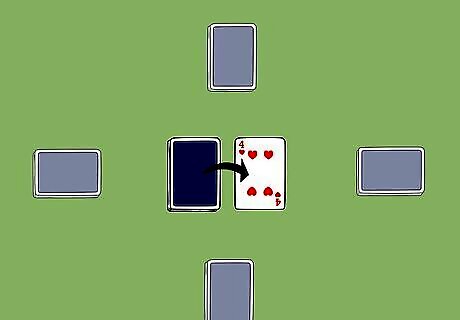
Flip the top card of the deck to set up the discard pile. Turn over the top card of the deck and set it face-up right next to it. If the card is a joker, 2, or a red 3, keep flipping cards from the deck until it’s a 4 or higher. When jokers, 2s, or 3s are discarded, they “freeze” the discard pile. Turn these cards sideways. We’ll cover what that means and how to unfreeze the discard pile a little further down.
Cards and Melds
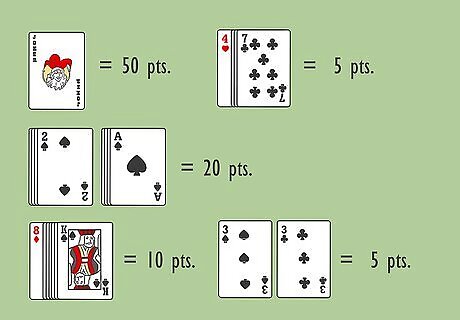
Card values Every card in a game of Canasta is worth points at the end of the round. Playing cards during a round earns you points, but cards left in your hand at the end of the game subtract from your score. The card point values are: Red 3s: 100 points Jokers: 50 points Aces and 2s (deuces): 20 points Kings, Queens, Jacks, 10s, 9s, and 8s: 10 points 7s, 6s, 5s, 4s, and black 3s: 5 points
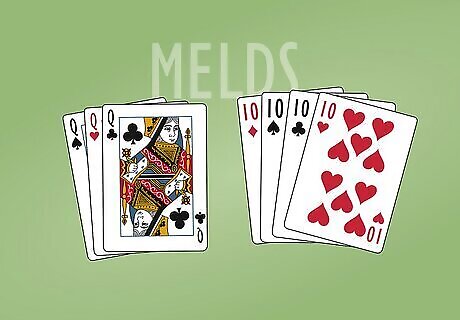
Melds Melds are groups of 3 or more cards that have the same rank, such as Q-Q-Q or 10-10-10. Jokers and 2s are wild cards, so they count as any rank in a meld. When you play cards from your hands, you either play a new meld or add cards to an existing meld. Aces down to 4s are considered “natural” cards. Melds must always have 2 natural cards when you play them.
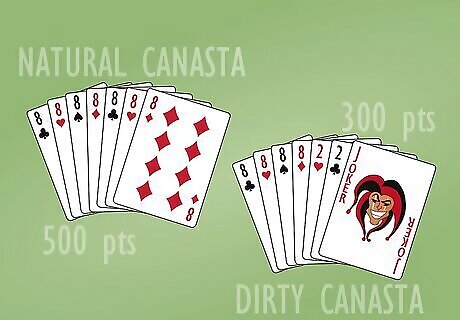
Canastas Canastas are melds of 7 or more cards of the same rank. Canastas can be formed like normal melds with a mix of natural and wild cards. Canastas earn big points and teams need to form one during a round if they want to go out first. A “natural” canasta is a meld of 7 or more cards without using any wilds and is worth 500 points. If there’s at least 1 wild card, then it’s considered a “dirty” canasta and is worth 300 points.
Gameplay
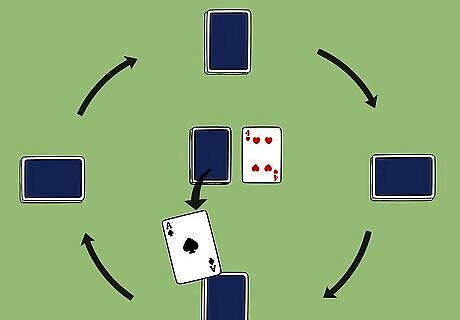
Draw a card from the deck or take the discard pile. The player to the dealer’s left takes the first turn. At the start of your turn, choose to either draw the top card of the deck or take all of the cards in the discard pile. While you’re always able to draw a card on your turn, there are some restrictions for taking the discard pile. You can only take the discard pile when it’s frozen if you have 2 natural cards in your hand matching the top card’s rank. This immediately unfreezes the discard pile. When the discard pile is unfrozen, you may take all the cards if you’re able to use the top card immediately in any meld. If you have a red 3 in your hand, play it face-up in front of you and draw a replacement card before choosing the next cards to take. If you draw a red 3, play it right away in front of you and draw a new card.
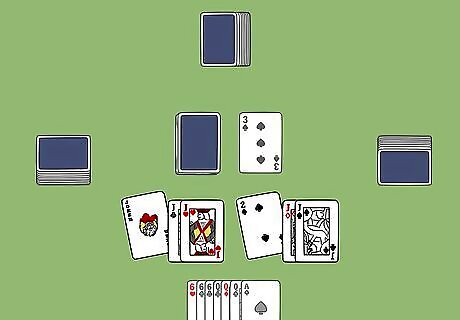
Play cards face-up into melds. After taking cards, the player can put down any groups of cards to form melds. Lay out the cards so it’s easy to see how many there are in each meld. If a player already has melds from past turns, they can add wilds or natural cards of the same rank to them. Teammates share melds, and can never have 2 separate melds of the same rank. You may only meld black 3s if they cause you to play all the cards in your hand. The first melds each team plays must be worth a set number of points based on the team’s current score. At the start of the game, the total for the melds played must be worth 50 points.
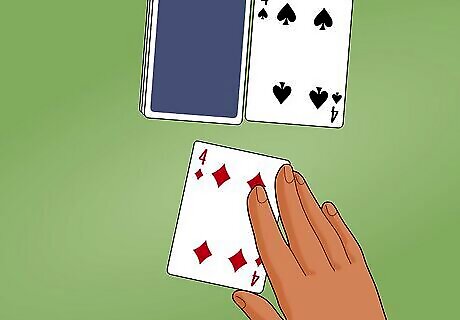
Discard a card at the end of the turn. The current player picks one card from their hand that they don’t want to keep and places it on top of the discard pile. If the card is a joker, 2, or 3, the discard pile is considered frozen.
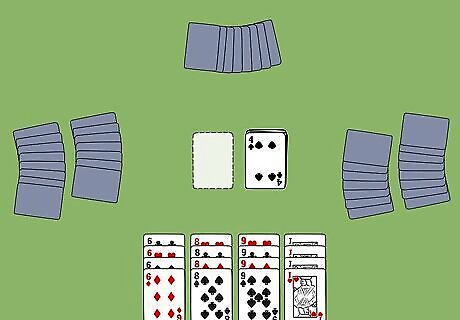
End the round when someone plays or discards their last card. If their team has at least one canasta, a player can use the last card in their hand in a meld or discard it to end the round. If a player only has one card in their hand but their team doesn’t have a canasta, they cannot discard their last card. If a player can go out but isn’t sure if their teammate wants to score more points, they can ask “May I go out?” Their teammate can either say yes or no, and the player must do what they’re told. Alternatively, the game can end when the stock runs out of cards. Because players can’t draw cards at the start of their turn, they must take the discard pile and meld it immediately. If they’re not able to play the card, then the game ends.
Round Scoring
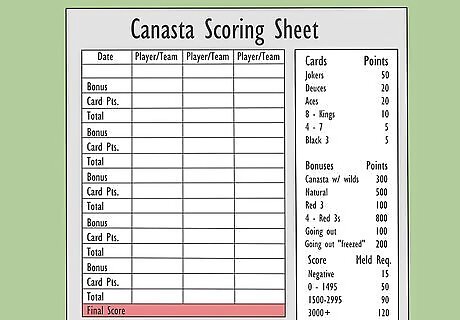
Count the points from red 3s and melds. Add up the point values of all the cards played into melds for each team, and write it down on a piece of paper. As a reminder, the card values are: Natural canasta: 500 points Dirty canasta (with wild cards): 300 points Red 3s: 100 points Jokers: 50 points Aces and 2s (deuces): 20 points Kings, Queens, Jacks, 10s, 9s, and 8s: 10 points 7s, 6s, 5s, 4s, and black 3s: 5 points If your team is able to collect all 4 of the red 3s, then they are worth a total of 800 points instead.
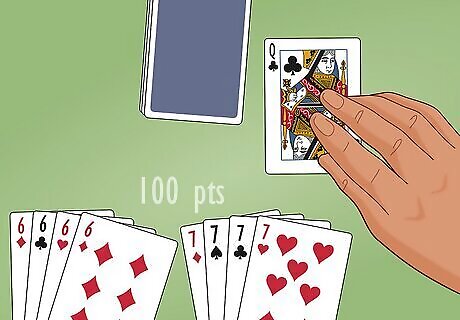
Earn 100 bonus points for going out. When a team goes out for the round, they get extra points for being the first to play all their cards. If they make a canasta and go out on the first time they meld cards, it’s considered “concealed” and is worth 200 points instead.
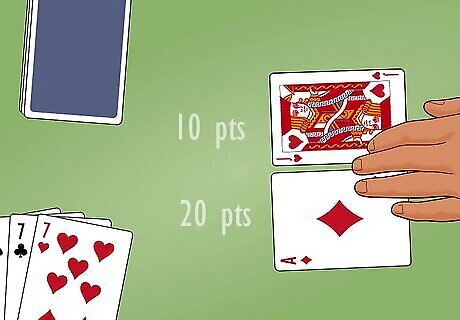
Subtract points for the cards left in players’ hands. Count the total points still left in players’ hands. Subtract those points from the team’s score. It’s possible to have a negative score if you had more points in your hand than in melds. If you collected red 3s but your team doesn’t have any melds, then each one subtracts 100 points from your team’s score.
Continuing the Game & Winning
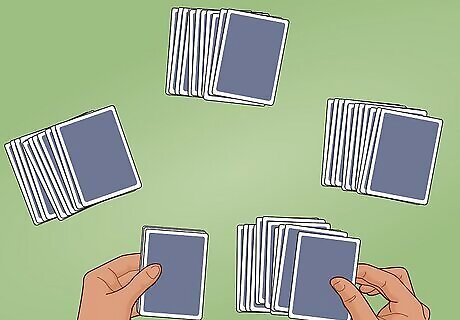
Shuffle and deal the cards to start the next round. Collect all of the cards and shuffle them together into a new stock. The person to the left of the first dealer becomes the new one and passes out 11 cards to each player.
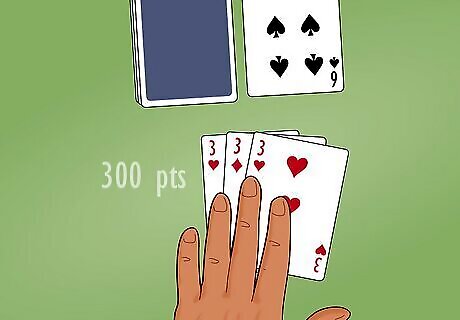
Meet the minimum points for your initial meld based on your score. All rounds of Canasta are played the same, but teams must reach a minimum number of points the first time they play melds. The number of points depends on the team’s current score. Negative: 15 points 0–1,495: 50 points 1,500–2,995: 90 points 3,000 or more: 120 points
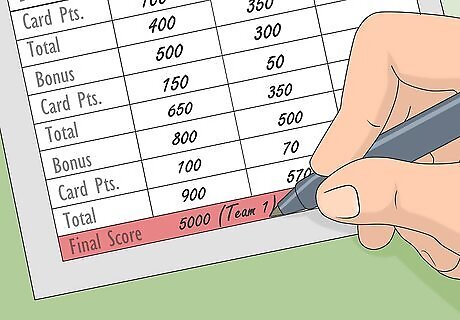
Play the game until a team reaches 5,000 total points. Continue playing rounds and counting scores. Whenever a team earns at least 5,000 points, they win the game! If multiple people get there in the same round, then whoever has the most points wins.
Strategies
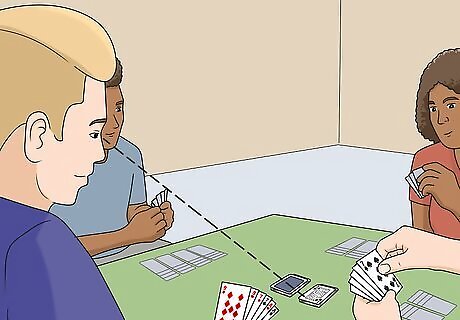
Keep an eye on what cards your opponent plays and discards. Watch what each player gets rid of from their hand, and check if those cards would work well in your hand. That way, you can take the discard pile to make large melds. Also, pay attention to what your opponents play to see what cards they’re interested in picking up. For example, you know there are only 8 Jacks. If your opponent lays down 3 of them in a meld, you know there are only 5 left in the other hands or the draw pile.
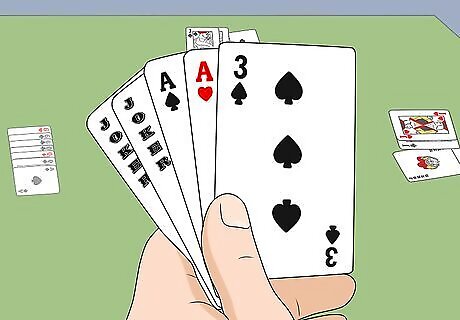
Save melds in your hand to throw off your opponent. Laying down your cards right away shows your opponents your hand. Your opponent could hold onto cards of that rank so you’re unable to score them. Hold onto your melds until you have a majority of the cards of that rank. Remember that as long as you have 2 cards of the same rank in your hand, you can pick up the discard pile if the top card matches.
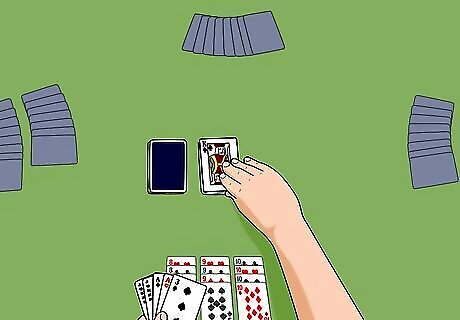
Pick up the discard pile when it is full of high cards. Wait until the discard pile has cards that have higher point values to take them. Keep your eye on what cards have been discarded, and take the pile if you’re able to use the cards in your melds. Having more cards in your hand gives you more opportunities to play, but it can be risky if other players are close to going out. Watch what other players are doing to see if taking a big discard pile is worth it.
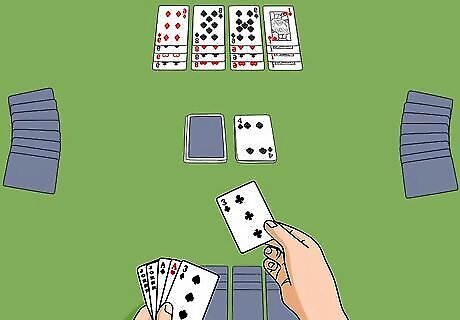
Discard cards to trick your opponent. If you suspect your opponent is holding onto something you need, try throwing down one of your cards to see what your opponent does. This works best when the discard pile is frozen so nobody can pick it up unless they can make a meld. Your opponent might put down a card you need. Keep 2 cards of the same rank in your hand so you can pick up the discard pile when it’s your turn again. Another option is to put down a card that you think your opponent needs to force them to pick up a large discard pile of subpar cards. Go out after that to leave them high and dry with a lot of cards.
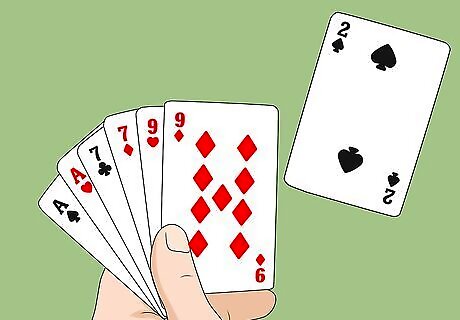
Play your wildcards when you're able to. The 2s and Jokers are worth a lot of points, so play them into melds as soon as you can so they don’t get stuck in your hand. Don’t risk putting them in the discard pile to freeze it because you could give your opponent more points. If your opponent is about to go out, play your valuable wildcards as soon as possible. Remember that you can add wild cards to an existing meld your team already played.
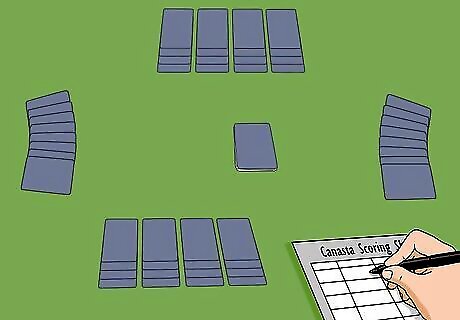
End the game as the draw or discard pile runs low. When the draw pile is low or when an opponent takes a large discard pile, make your melds and try going out as soon as possible. Even if you don’t have a lot of points on the table, you could force your opponent to take a lot of negative points.
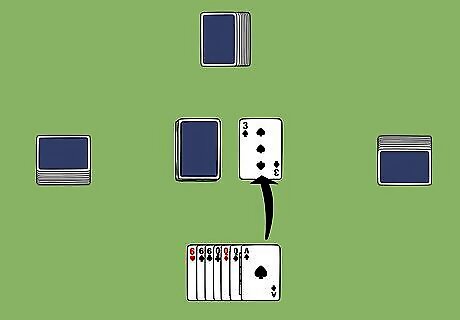
Play black 3s to block the next player in turn from taking the discard pile. Since black 3s have to be melded last, an opponent can’t take the discard pile after you get rid of one. That gives your partner a chance to pick up the discard pile on their turn.















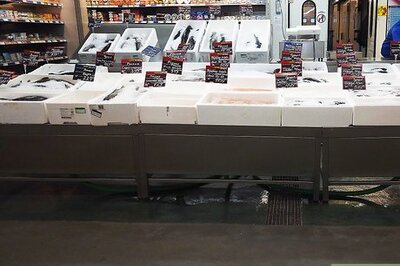


Comments
0 comment